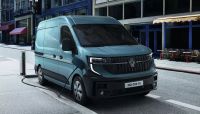
New Renault Master E-Tech electric Van
London, 31 January 2024, (Oilandgaspress): –Renault has chosen two batteries optimised for capacity, size and mass, combined with in-depth work on aerodynamics and a brand-new innovative platform.
The van comes with a choice of two energy storage capacity ratings: 40 kWh and 87 kWh. These two packs are built into a single casing and designed for driving requirements in cities as much as in suburbs. And they do not hamper the vehicle’s payload capacity – which is an essential criterion in this segment.
Renault optimised the van’s range by tackling it from two angles: the “Aerovan” concept and the multi-energy platform (encompassing the main motor, innovative dynamic braking system and battery heat management system).
It is the “Aerovan” design that provides the highest efficiency in its category regardless of the energy source. Its SCx is over 20% lower, ranking the van at the top end of the segment.
New Renault Master E-Tech electric was engineered in a wind tunnel. Its silhouette and every single part were honed to perfection. The prototypes spent thousands of hours in the tunnel during development then, given the van’s size, certification tests were carried out in wind tunnel built for aircraft.
To address all professional users’ requirements, the powertrain’s performance was upgraded with a 300 Nm/105 kW motor and a transmission system with one of the highest ratios in the heavy electric van market.
The New Master E-Tech electric range includes vans with a maximum authorised laden mass of 4 tonnes and towage muscle never seen before in the segment, without compromising handling, even in the fast lane.
The battery heat management system keeps the temperature constant, which increases the battery’s performance and extends its useful life.
The cab air conditioning system (which comes as standard) also helps to keep indoor temperature at optimal levels and the van’s range as long as possible, in summer as much as winter.
The dynamic braking system – a first in an LCV – also limits the number of components in the motor compartment (an internal motor actuates the brakes).
Besides providing a braking boost, the system responds faster, which also improves the vehicle’s active safety. By uncoupling the driver’s pressure on the pedal from the braking mechanism, the system can turn the kinetic energy from the deceleration into electric power to charge the battery and extend its range. The system can harvest up to 95 kW of energy this way.
All this work has improved efficiency in very real ways: New Renault Master consumes 27% less energy than the current generation, has a 460 km WLTP range and its payload capacity is substantial.
New Renault Master E-Tech electric boasts 1,625 kg of payload capacity (in a van requiring a B-category driving licence) and can tow 2.5 tonnes. Its consumption remains reasonable, at 21 kWh/100 km (WLTP) with the 87 kWh battery.
A 130 kW DC fast charge adds 252 km of range in 30 minutes. A 22 kW AC home Wallbox tops up the battery from 10% to 100% in under 4 hours.
New Renault Master E-Tech electric is powered by a 96 kW or 105 kW motor, in both cases delivering 300 Nm of torque. The first runs on a 40-kWh battery and has an approximately 200 km WLTP range (pending certification), the second runs on an 87 kWh battery with an up to 460 km WLTP range.
Information Source: Read More “
Energy Monitors , Electric Power , Natural Gas , Oil , Climate , Renewable , Wind , Transition , LPG , Solar , Electric , Biomass , Sustainability , Oil Price , Electric Vehicles,

